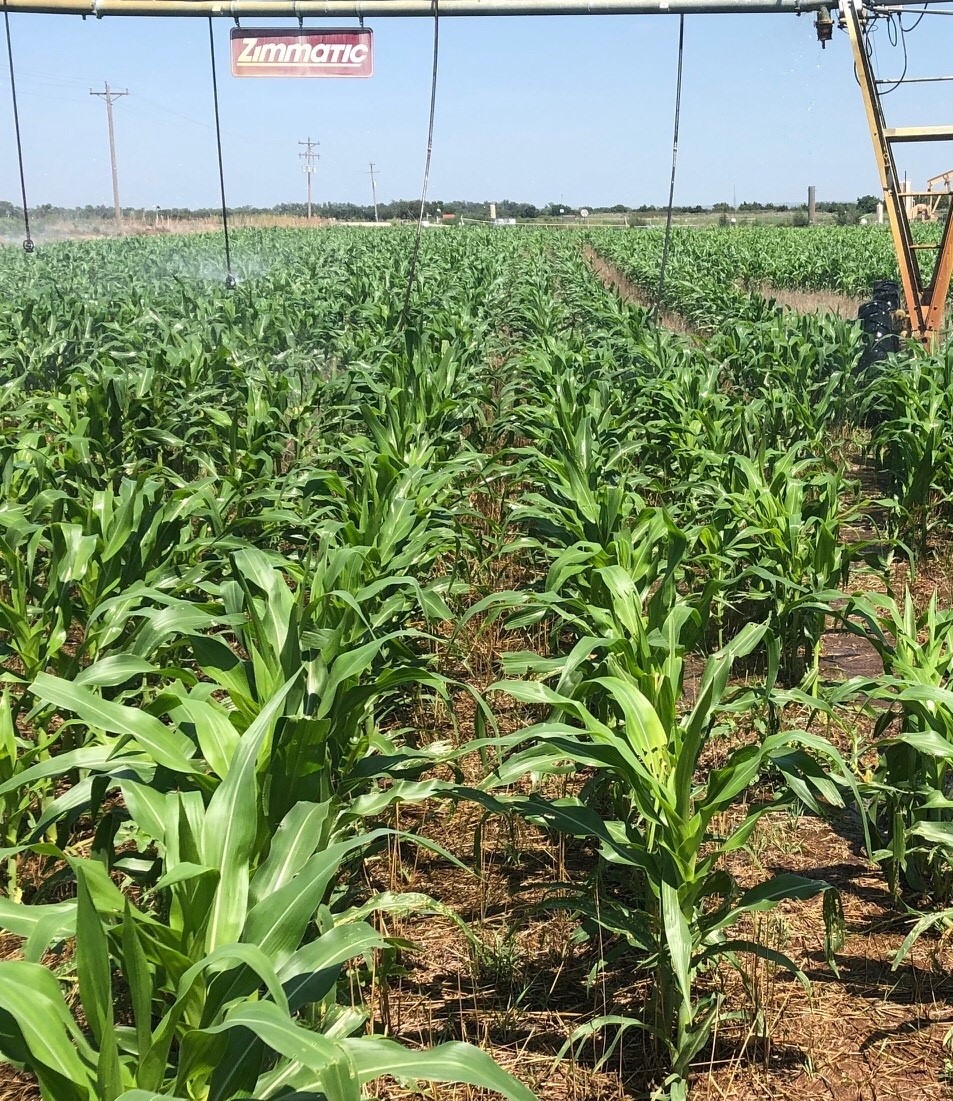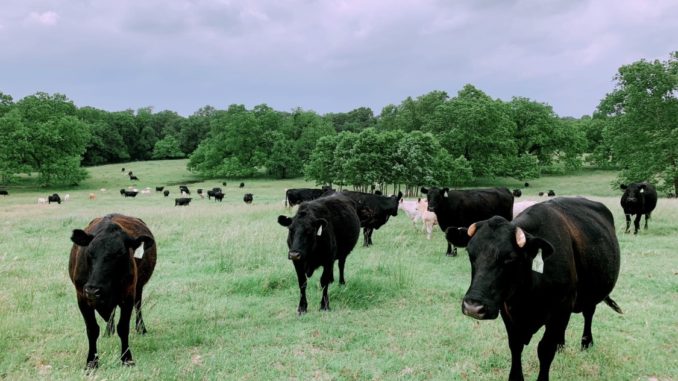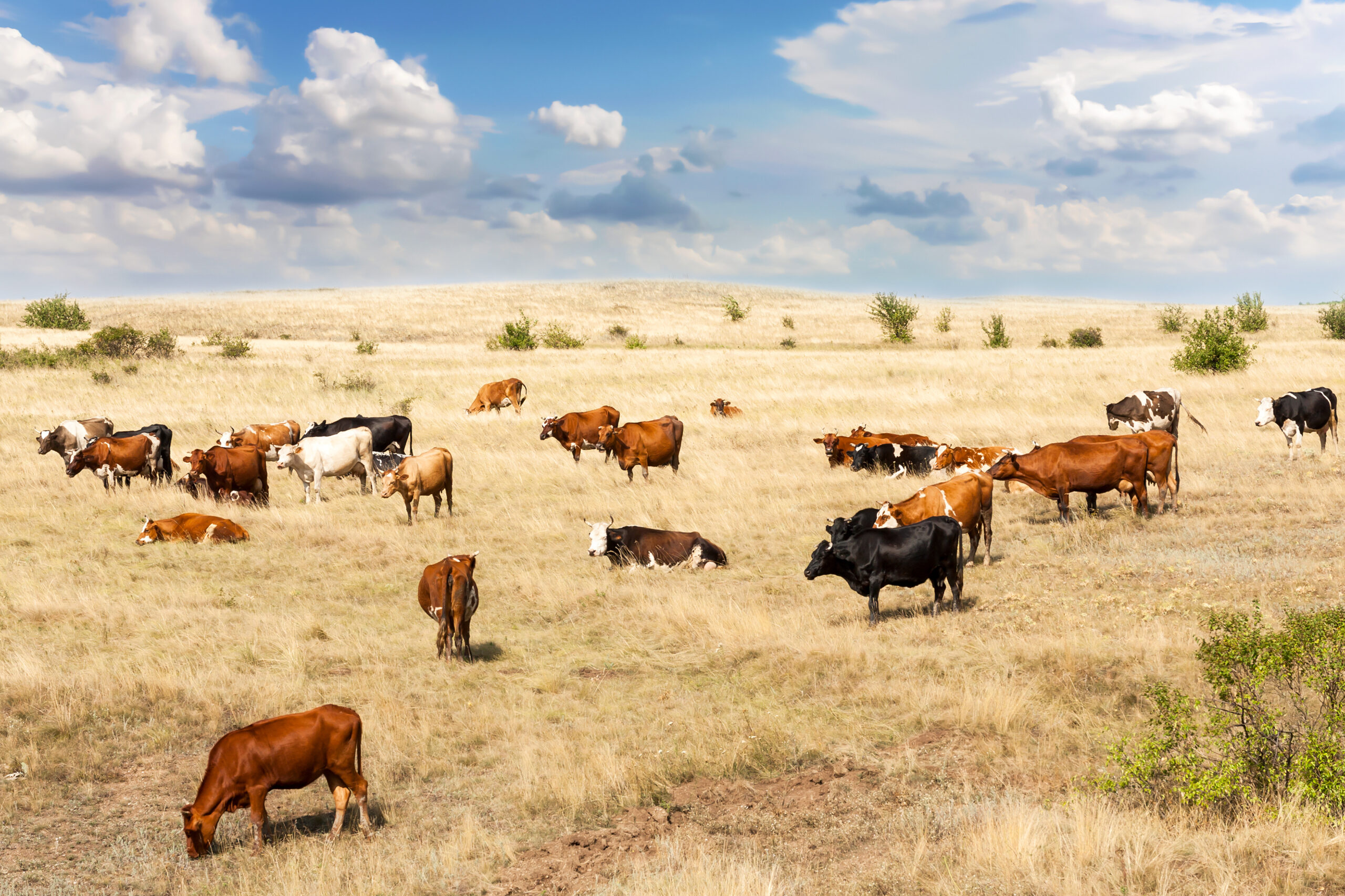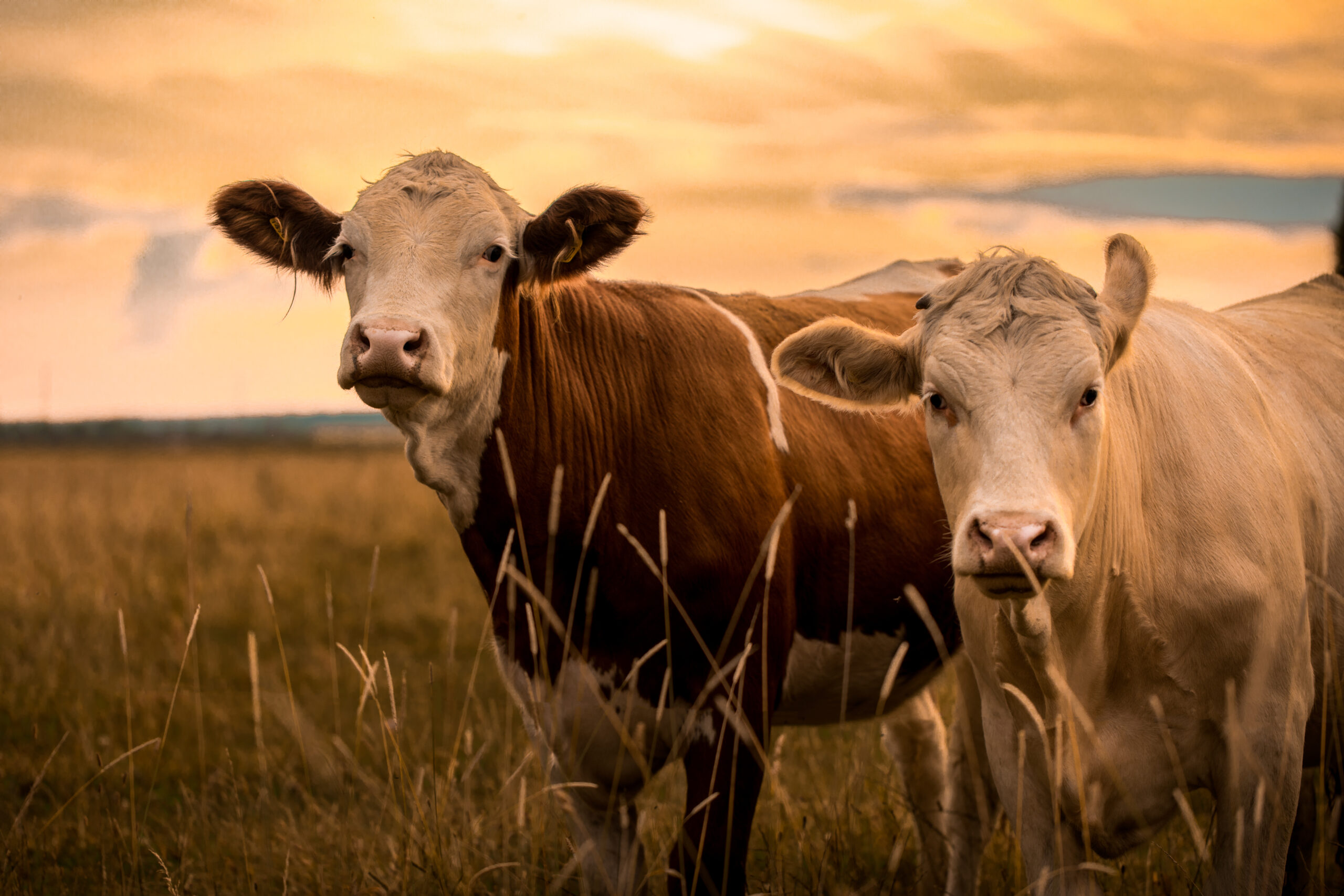Farm & Ranch
Infiltration Test Clearly Shows Benefits of Good Soil Health Management

Just about everyone’s heard of or experienced being dirt poor.
How would you like to be soil rich?
Western Oklahoma producer Jimmy Emmons, featured this summer in Oklahoma Farm & Ranch magazine, has worked with the Oklahoma Conservation Commission (OCC), the Natural Resources Conservation Service (NRCS) and the Oklahoma Association of Conservation Districts (OACD) to build a bank of sorts in his soil. It’s not money he keeps down there, but rather water. However, by using the soil as a reservoir that soil can benefit the land and the producer all the way to the bank.
“I tell everybody that our average rainfall is 20 inches, give or take 20 inches,” said Emmons, who lives near the community of Leedey in Dewey County. “In 2011, we had 7 inches, in 2012 we had 9 inches. Then soon after in another year, we had 25 in the month of May. We are seeing big extremes in the weather in the last several years. So, where we really want to hit home is with these weather extremes and how we lessen that effect. If I can take in 6-7-8 inches of a 12-inch rainfall within an hour, then I have no runoff and I have no loading of nutrients in the stream. I’m banking that for future use so when we roll into the dry spell, then we have the profile, we have that to work with. It’s all about storing it in the bank…in the reservoir.”
Before Emmons began applying soil health management, he could only apply a 1/2 inch of water before water would start running off the field. The infiltration was so poor he couldn’t apply enough water for a crop. Since that time, Emmons has been applying no-till, crop rotation, cover crops, and strategic grazing. The soil has healed dramatically.
So, this year, Emmons and his Soil Health partners of the OCC and NRCS have taken to those fields together to conduct soil infiltration tests. Think of it as an audit.
When they conducted this test, they brought in a 4.5 feet diameter by 5 inch steel ring (wagon wheel) and hammered it into the surface about two inches. Then they turned on the irrigation system to add “rainfall.” They put a rain gauge out to measure the water and waited.
“On our test day we applied 6.5 inches of water in about 4 hours,” said Greg Scott, OCC Soil Scientist. “There was zero runoff from the irrigated strip that was about 1/4 mile long and 30 feet wide. The irrigation system stayed in place during our test.”
The soil was uniformly wetted throughout the profile to about 4 feet deep. There was no standing water within a few minutes of turning off the irrigation.
When Emmons changed his soil management practices, he unlocked opportunities.
That’s why the soil absorbs the water so quickly and so deep. The soil scientists would like to dig down in the soil and see a rate of at least 15 earthworms to a square foot. Here, they found a rate of about 30 earthworms to a square foot. That is critical because those worms creates holes/paths/cracks that makes it easier for the water to run or absorb into.
“I’ve been playing in soil for about 45 years and this is the most fun we’ve ever had,” Scott said. “That’s because we’ve discovered how fast a soil ecosystem can heal and come back to life when we apply the principles of what we call soil health. This soil is gorgeous. This soil is dark, and soft and friable, it’s got good structure. Which you may not think there’s anything to this, but in 2011 the soil was light colored. Every time the wind blew it got up and left, every time it rained there were gullies in this field, and so we’re seeing a remarkable transformation that Jimmy has accomplished.”
That accomplishment is not just a matter of applying a few practices. Instead it centers on realizing that this whole ecosystem is made up of these parts that work together – diversifying.
Steve Alspach, NRCS State Soil Scientist, said, “I know Jimmy’s done some grid sampling out here over the last 5-6 years and if I remember my numbers correctly, about 70 percent of this field was below 1 percent organic matter during that first round in 2014 or 2015. I haven’t seen the latest numbers, but I know the second round he did it, over 80 percent was above 1 percent. So I would guess now, probably every acre out here is above 1 percent and it’s because of a few seasons of good crop rotation and the addition of those covers.”
So Emmons added about 30,000 pounds per acre of organic matter, about 25,000 pounds of carbon, and somewhere over a ton of nitrogen that’s being stored and is active in this soil. It is not only a source of nutrients for the future, but it also feeds and fuels all of that underground ecosystem, it feeds and fuels the bacteria and fungus that are beneficial to our plants, and makes a huge difference in how this soil functions hydrologically.
“We have turned this from a soil that every time it rained we got a gully to now it’s a system where we can put on 6 inches of water in less than 4 hours with no runoff,” Scott said. “Most people would look at that and say, ‘That’s impossible that can’t be done, not even healthy soils are expected to take that much water.’ This soil does.”
Emmons relies primarily on legumes in this rotation to get nitrogen into the system. Once it’s in the system, Scott said, “We can cycle it over and over through the plants.”
“He gets a huge diversity when he plants a multi-species cover crop,” Scott said. “Those cover crops are an important part of this because when he has a cover crop out here, typically he harvests it with cattle. Livestock and grazing animals are an essential part of the ecosystem because they reduce a lot of the carbon real quick.
The improvements have been so dramatic that Scott and Alspach believe the soil classification of this field have changed.
So, Emmons turned, looked at Alspach and asked a straight forward question, “If we could get producers across Oklahoma and across the country to do what we’ve done here, how would that help us during droughts and floods in the future?”
Alspach nods his head, grins and says, “Under a conventional system where we’re tilling a lot or plowing a lot, depending on the slope and the texture of the soil, we see quite a bit of runoff. I would say on average, on a fairly good hard rain, we would see that 30 to 40 percent of the rain that falls would run off, go right into the nearest creek, into the river and head for the Gulf of Mexico.”
That’s just due to infiltration problems. Those bare soils seal over and a field starts having runoff pretty quick after the onset of the storm. However, as this field shows, if producers can get better infiltration, they can put that in the soil profile.
During another test day, the Soil Health team put on 8 inches of water, “and we’re going to get water well past 40 inches in this soil profile and that’s just stored there for the plants to use.”
That pays numerous dividends.
“Some of it will be partitioned and move on down through gravitational forces into the water table and will eventually flow into the river,” Alspach said. “So it will help with base flow on the rivers and it just slows the time it takes that water from underground moving to the river, versus running on the surface to get there.”
That helps reduce the number of flood events and things of that nature.
“Again, when I started working with Jimmy he told me he could put on about a half of an inch at a time before he started getting runoff,” Alspach said. “Today we’re going to put on 8 inches on a spot and we’re going to have no runoff. So we’ve seen a huge change in the infiltration rate out here.”
Or put another way, a huge return on investment.
Read more in the November 2020 issue of Oklahoma Farm & Ranch.
Farm & Ranch
Cattle Nematodes (Worms)

Barry Whitworth, DVM | Senior Extension Specialist | Department of Animal & Food Sciences
According to the Mesonet, Oklahoma received some much-needed rain in late April (2023). With the moderate temperatures and high humidity, the environment is perfect for the proliferation of gastrointestinal nematodes (GIN) which are commonly called “worms.” Cattle can be infected with a variety of GIN. Most do not cause issues unless husbandry practices are poor. However certain GIN have been associated with disease. The most pathological GIN in cattle is Ostertagia ostertagi. Cooperia species and Haemonchus species are two that have been implicated with production issues. Control of these parasites is constantly changing due to environment, anthelmintic (dewormer) resistance, and consumer preference. Cattle producers should develop a plan to manage these parasites.
In order for GIN to complete their life cycle, certain environmental conditions must exist. The development stage begins with passing of the egg in the feces of the animal. If the egg is to hatch, the temperature must be warm and the humidity needs to be close to 100%. Ideal temperature ranges from 70⁰ to 80⁰ Fahrenheit (F), but any temperature above 45⁰ F will allow for development. Temperatures above 85⁰ F or below 45⁰ F will begin to hamper development. Humidity needs to be 80% or higher.
Once the egg hatches, the larva goes through a couple of molts to reach the infective stage which is the third stage larva (L3). L3 must have moisture to free itself from the fecal pat. Once free, it rides a wave of water on to a blade of forage. Once ingested, this begins the prepatent or pre-adult stage. Two molts take place during this stage (L3 to L4 and L4 to L5). If conditions are not favorable for survivability of offspring, L4 will go into an arrested development stage (hypobiosis) for a period of time. The patent or adult stage is the mature breeding adult.
Once inside the body, the parasite will migrate to certain locations in the digestive tract. For example, O. ostertagi develop in the gastric gland in the abomasum. H. placei and H. contortus will migrate to the abomasum. Cooperia species will live in the small intestine. A few like Trichuris (whipworms) are found in the large intestine.
Clinical signs of parasitism vary according to the species of parasite, burden, and site of attachment. Severe disease, which is referred to as parasitic gastroenteritis (PGE), with internal parasites is unusual with today’s control methods. Clinical signs of PGE are lack of appetite, weight loss, weakness, diarrhea, submandibular edema (bottle jaw), and death. However, most parasite infection are subclinical which means producers do not see clinical signs of disease. In subclinical infections, the parasite causes production issues such as poor weight gain in young cattle, reduced milk production, and lower pregnancy rates.
Producers should be monitoring their herds for parasites throughout the year but especially in the spring when conditions are ideal for infection. A fecal egg count (FEC) is a good way of accessing parasite burdens. Livestock producers need to gather fecal samples from their herd periodically. The samples should be sent to their veterinarian or a veterinary diagnostic lab. Different techniques are used to access the number of eggs per gram of feces. Based on the counts, the producer will learn the parasite burden of the herd. Producers can use this information to develop a treatment plan.
In the past, GIN control was simple. Cattle were routinely dewormed. Unfortunately, anthelmintic resistance has complicated parasite control. Now proper nutrition, grazing management, a general understanding of how weather influences parasites, biosecurity, refugia, anthelmintic efficiency, and the judicious use of anthelmintics are important in designing an effective parasite management program. All of these considerations need to be discussed in detail with a producer’s veterinarian when developing a plan for their operation.
Cattle producers need to understand that parasites cannot be eliminated. They must be managed with a variety of control methods. Designing a parasite management plan requires producers to gain a general understanding of life cycle of the parasite as well as the environmental needs of the parasite. Producers should use this information as well as consult with their veterinarian for a plan to manage GIN. For more information about GIN, producers should talk with their veterinarian and/or with their local Oklahoma State University Cooperative Extension Agriculture Educator.
References
Charlier, J., Höglund, J., Morgan, E. R., Geldhof, P., Vercruysse, J., & Claerebout, E. (2020). Biology and Epidemiology of Gastrointestinal Nematodes in Cattle. The Veterinary clinics of North America. Food animal practice, 36(1), 1–15.
Navarre C. B. (2020). Epidemiology and Control of Gastrointestinal Nematodes of Cattle in Southern Climates. The Veterinary clinics of North America. Food animal practice, 36(1), 45–57.
Urquhart, G. M., Armour, J., Duncan, J. L., Dunn, A. M., & Jennings, F. W. (1987). In G. M. Urquhart (Ed). Veterinary Helminthology. Veterinary Parasitology (1st ed., pp 3-33). Longman Scientific & Technical.
Farm & Ranch
The Value of Vitamin A

Barry Whitworth, DVM – Area Food/Animal Quality and Health – Specialist for Eastern Oklahoma
A ranch in Australia experienced an abnormally high number of stillbirths and weak born calves in 2004-2005. An investigation revealed that the usual infectious causes were not the problem. After additional testing, veterinarians diagnosed low levels of vitamin A as the cause.
According to Dr. Greg Hanzlicek, with the Kansas State Veterinary Diagnostic Laboratory (KSVDL), Kansas had an unusually high number of stillbirth cases and weak born calves in the spring of 2019. After many laboratory tests, it was concluded that the problem stimmed from a lack of energy, protein, Vitamin A, or combinations of all of these.
Both of the above examples demonstrate the importance of vitamin A in reproductive efficiency. Research has shown that low vitamin A levels during pregnancy are associated with abortions, stillbirths, and weak born calves. In addition to playing an important role in reproductive efficiency, vitamin A is essential for vision, bone growth, and maintaining epithelial tissue such as skin and hooves.
Animals obtain vitamin A from consuming green forage and/or the addition of vitamin A supplements to the diet. Lush green pastures contain high amounts of vitamin A. As plants mature and during times of drought, the amount of vitamin A decreases. The ranch in Australia experienced below average rainfall in the previous two years prior to the calving season. During the calving season, rainfall was below average with very dry conditions and little green forage was available.
In general, animals obtain adequate amounts of vitamin A by grazing green forage. Animals grazing green pastures will build a healthy store of vitamin A in the liver. When vitamin A is in short supply, the stores in the liver prevent deficiencies. According to Dr. Lalman, Extension Beef Cattle Specialist Oklahoma State University, the stores should last 2 to 4 months during times of deficiency. During times when green forage is not available, vitamin A supplements need to be added to the diet to prevent deficiencies.
When vitamin A levels are deficient, night blindness is one of the earliest clinical signs. Other eye issues include clouding of the cornea, ocular discharges, and possible ulcerations. Skin issues found when levels of vitamin A are deficient include a dry rough coat, scales on the skin, and dry cracked hooves. Other neurological signs include incoordination or gait problems. Seizures may occur due to the increase cerebrospinal fluid pressure. Birth defects have also been attributed to low vitamin A levels.
Animals displaying vitamin A deficiency should be treated immediately with vitamin A injections. If treated early, response is usually rapid and complete. However, delaying treatment may result in irreversible damage. Even with treatment, cattle with vision impairment due to vitamin A deficiency may not regain their sight.
Preventing Vitamin A deficiency depends on producers being attentive to the environmental conditions that favor low vitamin A levels in forage. During these times, producers need to supplement the diet with vitamin A. Producers need to be aware that Vitamin A supplements degrade rapidly, so vitamin A supplements should not be stored for long periods of time. In addition to vitamin A supplementation, research indicates that diets low in protein result in poor absorption of vitamin A. It is important that producers ensure that the rations have sufficient protein levels. Lastly, since colostrum contains high levels of vitamin A, producers need to ensure that newborns obtain adequate amounts of colostrum at birth.
Similar to the Australian example, most of Oklahoma had below average rainfall for the year of 2022. This resulted in pasture quality decreasing earlier than normal. Due to this year’s lack of green forage, liver stores of vitamin A may be inadequate for the animal’s needs. Producers need to ensure that the diets of their cattle have adequate amounts of vitamin A, energy, and protein. For more information about Vitamin A, producers should contact their veterinarian and/or visit with their Oklahoma State University County Ag Educator.
References
Hanzlicek, G. (2019, May). Difficult Calving Season Findings:2019. Diagnostic Insights. www.ksudl.org/resources/news/diagnostic_insights/may2019/difficult-calving-season2019.html.
Hill, B., Holroyd, R., & Sullivan, M. (2009). Clinical and pathological findings associated with congenital hypovitaminosis A in extensively grazed beef cattle. Australian Veterinary Journal, 87(3), 94–98.
Parker, E. M., Gardiner, C. P., Kessell, A. E., & Parker, A. J. (2017). Hypovitaminosis A in extensively grazed beef cattle. Australian veterinary journal, 95(3), 80–84.
Farm & Ranch
Lice in Cattle

Barry Whitworth, DVM, MPH | Senior Extension Specialist
Department of Animal & Food Sciences | Freguson College of Agriculture | Oklahoma State University
Cattle lice cost Oklahoma cattlemen millions of dollars each year in decreased weight gains and reduced milk production. If cattle producers have not treated their cattle for lice this fall, they need to consider what type of lice control to initiate. This is especially true for cattle producers that had problems in the previous year. Cattle producers should monitor cattle closely during the months of December, January, and February. Producers should not wait until clinical signs appear before beginning treatment.
The life cycle of the different species of cattle lice are very similar. The life cycle begins with the female louse attaching her egg to a shaft of hair. The egg will hatch as a small replica of the adult. After several molts, the adult will emerge. The cycle takes around 3 to 4 weeks to complete. These newly hatched lice will spend their entire life on the host and are host specific which means cattle cannot be infected with lice from other animals.
Small numbers of lice may be found on cattle in the summer, but high populations of lice are associated with cold weather. Since cattle tend to be in closer proximity to each other in the winter, lice can spread easily between cattle. A small percentage of cattle tend to harbor larger numbers of lice. These animals are sometimes referred to as “carrier animals”, and they may be a source for maintaining lice in the herd. As with many other diseases, stress also contributes to susceptibility and infestation.
Signs of lice infections in cattle are hair loss, unthrifty cattle, and hair on fences or other objects. If producers find these signs, they may want to check a few animals for lice. They can check for lice by parting the hair and observing the number of lice per square inch. If an animal has 1 to 5 lice per square inch, they are considered to have a low infestation. Cattle with 6 to 10 lice would be considered moderately infested. Any cattle with more than 10 lice per square inch are heavily infested.
Cattle have two types of lice. One type is the biting or chewing louse. These lice have mouth parts that are adapted to bite and chew the skin. The second type is sucking louse. These lice have mouth parts that will penetrate the skin and suck blood and other tissue fluids. It is not uncommon for cattle to be infested with more than one species of lice.
The biting or chewing louse is Bovicola (Domalinia) bovis. This type of lice feeds on hair, skin, skin exudate, and debris. Typical clinical signs with this type of louse are hair loss, skin irritation and scabs on the skin. They are found on the shoulders and back.
Four types of sucking lice can be found in the United States. The first is the “short nose” louse or Haematopinus eurysternus. This is the largest cattle louse. This louse is found on the neck, back, dewlap, and base of the tail. The second is the “long-nose” louse or Linognathus vituli. This louse is bluish in color with a long slender head. This louse is found on the dewlap, shoulders, sides of the neck, and rump. The third is the “little blue” louse or Solenoptes cappilatus. This louse is blue in color and is the smallest cattle louse. This louse is found on the dewlap, muzzle, eyes, and neck. The last is the “tail” louse or Haematopinus quadripertuses. This louse has been found in California, Florida, and other Gulf Coast States. This louse is found around the tail.
The sucking lice have the potential to cause severe anemia if the numbers are high. This can result in poor doing cattle or in extreme cases death. They also can spread infectious diseases. The long-nose louse has been found to be a mechanical vector for anaplasmosis.
Prevention of lice infestation should begin in the fall. Producers should not wait for clinical signs to appear before beginning treatment. Several products are available to control lice. Producers should read and follow the label directions. Producers should keep in mind that many of the lice control products require two administrations to control lice. Failure to do this may result in cattle having problems with lice infestations.
Some producers have complained that some products do not work. These complaints have not been verified; however, this is a good reason to consult with a veterinarian for advice on what products to use. Most treatment failures are associated with incorrect application not resistance. Proper application of Pour-On insecticides is to administer from the withers to the tailhead. Also, the proper dose is essential for good control.
Cattle producers need to consider a few other things in lice control. Since cattle in poor body condition are more prone to lice infestation, producers need to be sure that the nutritional needs of their cattle are being met. Cattle that have a history of lice infestations should be culled. Lastly, any purchased cattle need to be inspected for lice before entering the herd. If lice are found, the animals should be isolated and treated before entering the herd.
If producers would like more information on lice in cattle, they should contact their local veterinarian or Oklahoma State University County Extension Agriculture Educator. They may also want to read Oklahoma Cooperative Extension Fact Sheet Beef Ectoparasites VTMD-7000 at https://extension.okstate.edu/fact-sheets/beef-cattle-ectoparasites.html.
-

 Attractions8 years ago
Attractions8 years ago48 Hours in Atoka Remembered
-

 Country Lifestyle9 months ago
Country Lifestyle9 months agoJuly 2017 Profile: J.W. Hart
-

 Country Lifestyle9 years ago
Country Lifestyle9 years agoThe House a Treasure Built
-

 Country Lifestyle4 years ago
Country Lifestyle4 years agoThe Two Sides of Colten Jesse
-

 Outdoors7 years ago
Outdoors7 years agoGrazing Oklahoma: Honey Locust
-

 Equine8 years ago
Equine8 years agoUmbilical Hernia
-

 Outdoors5 years ago
Outdoors5 years agoPecan Production Information: Online Resources for Growers
-

 Farm & Ranch7 years ago
Farm & Ranch7 years agoHackberry (Celtis spp.)




